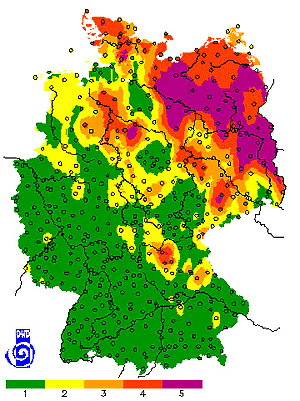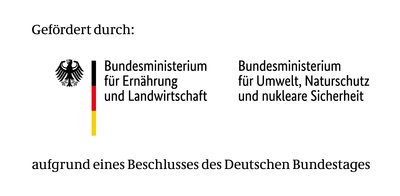Forest fire prediction
In order to reduce the number and extent of damage caused by forest fires it is necessary to know the actual forest fire danger. This allows the population and affected parties to be notified about the forest fire danger and to take appropriate prevention measures.
In Germany, the international Forest Fire Danger Index M-68 is used to forecast the forest fire danger situation. This method determines or predicts the actual forest fire danger and is used by the German Meteorological Service to provide country wide predictions and by state forest enterprises for state wide predictions. The operational calculation is carried out during the forest fire season from February/March until October and is based on official climate data from selected territorial weather stations belonging to the German Meteorological Service.
The midday values for air temperature, relatively humidity, 24 hour precipitation and wind speed recorded at the weather stations are used in the calculations. The morning snow depth is also captured during the spring months. Besides meteorological parameters, phenological criteria, such as vegetation, also play an important role in evaluating the fire danger. Indicator plants (these show certain environmental conditions like oxygen content or soil water content) are used to estimate the annual development of the forest groundcover and canopy layers. As a green groundcover and a leafy canopy hinder forest fire spread the potential danger is evaluated as lower. As precipitation is extremely diversely spatially distributed, additional precipitation monitoring stations are included when working out the calculations. Furthermore, forest landscapes are divided into three forest fire danger classes from A "high", B "medium" to C "low" according to the stand structure and climate due to their different ignition and burning capacity. In some of the eastern German states there is a further differentiation of Class A into A1 "Areas with a very high forest fire danger" and A "Areas with a high forest fire danger". This class division is taken into account during the final evaluation of the forest fire risk.
Forecasts for Germany

Fig. 1: Germany wide Forest Fire Danger Index M-68 for 5 June 2008. (Source: German Meteorological Service)
Country wide forest fire danger forecasts for the current day and following four days are published online by the German Meteorological Service as tables and maps on their "agro-weather page". Every day at 2pm, a valid and officially binding Forest Fire Danger Index for individual forest fire regions is calculated for the next day, as well as a prognosis for the following four days. The regional hazard situation is categorised by the German Meteorological Service into five forest fire danger classifications according to the international standard from 1 "very low" to 5 "very high". The next morning another Forest Fire Danger Index is made for the current day with any amendments due to weather conditions. This enables a flexible organisational response to changed meteorological conditions.
The Forest Fire Danger Index is used to inform the public via the usual media channels and by forest and fire fighting authorities as well as rescue and emergency services to implement their forest fire prevention measures in a timely manner. Furthermore, forest workers can be better prepared and the potential danger of recreational activities in forests can be more realistically estimated.
The German states of Mecklenburg-Western Pomerania and Brandenburg classify their state wide forecasts based on the regionally determined Forest Fire Danger Index not according to the international standard but according to the traditionally used M-68 Forest Fire Danger Scale on a scale from 0 to 4. The actual Forest Fire Danger Scale is published on the homepages of the Mecklenburg-Western Pomerania and Brandenburg state forest enterprises. Furthermore, the actual values are available at all necessary locations (e.g. rural district and municipalities centres, German Rail Agency, state utilities etc.) as well as publicised by the media.
Forecasts for Austria
In Austria the Central Institute for Meteorology and Geodynamics takes over the gathering and publishing of the forest fire danger, similarly based on a five tiered Forest Fire Danger Index. The data is based on an analysis of the mean temperature and precipitation of the previous fortnight. Further vegetative and forest related factors are not currently incorporated into the prognosis. Forecasts for the current and following day are accessible via the Central Institute for Meteorology and Geodynamics’ homepage.
| Table 1: Forest Fire Danger Scale. (Source: German Meteorological Service) | ||
| International | Degree of Danger | Original M-68 |
| 1 | Very little danger | 0 |
| 2 | Little danger | 1 |
| 3 | Moderate danger | 2 |
| 4 | High danger | 3 |
| 5 | Very high danger | 4 |
Literature
- Fleischer, J.; Böttcher, F.; Otto, L.-F.; Müller, J. (2010): Regionalisierte Waldbrand-gefahrenwarnung für Sachsen durch den deutschen Wetterdienst. AFZ-Der Wald 9: 38-41
- Gossow, H., Hafellner R., Vacik H., Huber T. (2009): Major Fire Issues in the Euro-Alpine Region – the Austrian Alps. International Forest Fire News (IFFN), 38, 1-10; ISSN 1029-0864
- König, H.-C. (2007): Waldbrandschutz. Kompendium für Forst und Feuerwehr. Supplement Band 1, Hrsg. Mathias Bessel, Fachverlag Matthias Grimm, 197 S.
- Mißbach, K. (1982): Waldbrand - Verhütung und Bekämpfung. VEB Deutscher Landwirtschaftsverlag Berlin. 3. stark überarbeitete Auflage. 108 S.
- Landesforst Mecklenburg-Vorpommern (1999): Durchführungserlass zum Gemeinsamen Waldbrandrunderlass des Ministerium für Landwirtschaft, Umwelt und Verbraucherschutz und Innenministeriums. Lesefassung 15. Juni 2009
Forest Crises Management Advisory Guide
Back to the main page of the Forestry Crisis Management Advisor Guide: Overview of the different topic collections
Back to the article overview in the: Forest fire Topic Collection


